A controversial new idea suggests that a large space rock exploded over North America 13,000 years ago.
""The blast may have wiped out one of America's first Stone Age cultures as well as the continent's big mammals such as the mammoth and the mastodon.
The blast, from a comet or asteroid, caused a major bout of climatic cooling which may also have affected human cultures emerging in Europe and Asia. Scientists will outline their evidence this week at a meeting in Mexico.
Their impact theory shouldn't be dismissed; it deserves further investigation -- Jeff Severinghaus, Scripps Institution of Oceanography
The evidence comes from layers of sediment at more than 20 sites across North America.
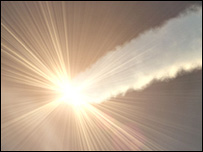 These sediments contain exotic materials: tiny spheres of glass and carbon, ultra-small specks of diamond - called nanodiamond - and amounts of the rare element iridium that are too high to have come from Earth.
These sediments contain exotic materials: tiny spheres of glass and carbon, ultra-small specks of diamond - called nanodiamond - and amounts of the rare element iridium that are too high to have come from Earth.All, they argue, point to the explosion 12,900 years ago of an extraterrestrial object up to 5km across.
No crater remains, possibly because the Laurentide Ice Sheet, which blanketed thousands of sq km of North America during the last Ice Age, was thick enough to mask the impact.
Another possibility is that it exploded in the air.
Climate Cooling
The rocks studied by the researchers have a black layer which, they argue, is the charcoal deposited by wildfires which swept the continent after the explosion.
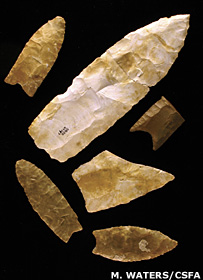 Clovis hunting points, Center for the Study of the First Americans The Clovis people developed an advanced stone tool technology The blast would not only have generated enormous amounts of heat that could have given rise to wildfires, but also brought about a period of climate cooling that lasted 1,000 years - an event known as the Younger Dryas.
Clovis hunting points, Center for the Study of the First Americans The Clovis people developed an advanced stone tool technology The blast would not only have generated enormous amounts of heat that could have given rise to wildfires, but also brought about a period of climate cooling that lasted 1,000 years - an event known as the Younger Dryas.Professor James Kennett, from the University of California in Santa Barbara (UCSB), said the explosion could be to blame for the extinction of several large North American mammals at the end of the last Ice Age.
"All the elephants, including the mastodon and the mammoth, all the ground sloths, including the giant ground sloth - which, when standing on its hind legs, would have been as big as a mammoth," he told the BBC.
"All the horses went out, all the North American camels went out. There were large carnivores like the sabre-toothed cat and an enormous bear called the short-faced bear."
Professor Kennett said this could have had an enormous impact on human populations.
Population Decline
According to the traditional view, humans crossed from north-east Asia to America at the end of the last Ice Age, across a land bridge which - at the time - connected Siberia to Alaska.
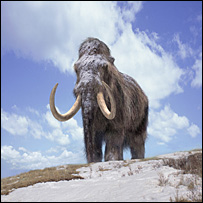 The Clovis culture was one of the earliest known cultures in the continent. These proficient hunter-gatherers developed a distinctive thin, fluted spear head known as the Clovis point, which is regarded as one of the most sophisticated stone tools ever developed. Archaeologists have found evidence from the Topper site in South Carolina, US, that Clovis populations here went through a population collapse.
The Clovis culture was one of the earliest known cultures in the continent. These proficient hunter-gatherers developed a distinctive thin, fluted spear head known as the Clovis point, which is regarded as one of the most sophisticated stone tools ever developed. Archaeologists have found evidence from the Topper site in South Carolina, US, that Clovis populations here went through a population collapse.But there is no evidence of a similar decline in other parts of the continent. The Clovis culture does vanish from the archaeological record abruptly, but it is replaced by a myriad of different local hunter-gatherer cultures.
Jeff Severinghaus, a palaeoclimatologist at Scripps Institution of Oceanography in California, told Nature magazine: "Their impact theory shouldn't be dismissed; it deserves further investigation."""
America got "nuked" in 12,500 BC!
""Traditional history tells us that the first people who entered North America came across the Bering Sea, from Asia, and migrated South to the continent around 12,000 BC. But this date has often puzzled archaeologists who place the migration in South America to a much earlier date -- around 32,000 BC. How can these two dates be so far apart?""
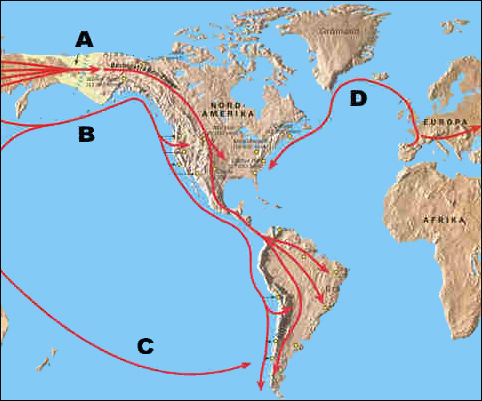
""Since no traces of the Homo habilis or the Homo erectus could be found in America, Archeologists conclude that America must have been settled by the Homo sapiens sapiens about 12,000 years ago There are 4 main migration-hypothesies:
A) People came via the BERING SRAIT from Sibiria to Alaska;
B) People from SIBIRIA crossed the Northern Pacific and landed on the American coast;
C) People from POLYNESIA crossed the Pacific Ocean and landed either in Northern or Southern America;
D) People from EUROPE crossed either the Atlantic Ocean or came via Russia and Sibiria to America.
So far there is only evidence for the Bering Strait Theory (A).
Recently, scientists have started questioning the methods used to date artifacts and strata in the earth that support this early (12000 BC) date. The traditional method, Carbon-14, has been used with confidence since it is based on well known principles of physics. But while the method may be well understood, certain natural phenomenon may have interfered with the sites in the Northern Hemiphere and caused the readings of Carbon 14 to be inaccurate. Specifically, scientists now believe that a nuclear explosion or a similar event could have changed the chemistry of Carbon 14 thousands of years ago, throwing off the real dates by thousands of years!
A pattern of unusually young radiocarbon dates in the Northeast has been noted by researchers and this indicates that the entire Great Lakes region (and beyond) was subjected to particle bombardment and a catastrophic nuclear irradiation that produced secondary thermal neutrons from cosmic ray interactions. The neutrons produced unusually large quantities of 239 Pu and substantially altered the natural uranium abundance ratios ( 235 U/238 U) in artifacts and in other exposed materials including cherts, sediments, and the entire landscape. These neutrons necessarily transmuted residual nitrogen (14 N) in the dated charcoals to radiocarbon, thus explaining the anomalous dates.
The evidence from dated materials
Scientists investigated a cluster of especially young radiocarbon dates concentrated in the north-central area of North America. For example, at the Gainey site in Michigan a 2880 yr BC radio-carbon date was reported, while the thermoluminescence date (a different dating test) for that same site is 12,400 BC!
Other anomalous dates were found at Leavitt in Michigan, Zander and Thedford in Ontario, Potts in New York, Alton in Indiana, and Grant Lake in Nunavut. The Grant Lake Paleoindian site is most remarkable because its 160 BC age is fairly young, while adjacent and deeper samples give ages of 1480 to 3620 BC.""
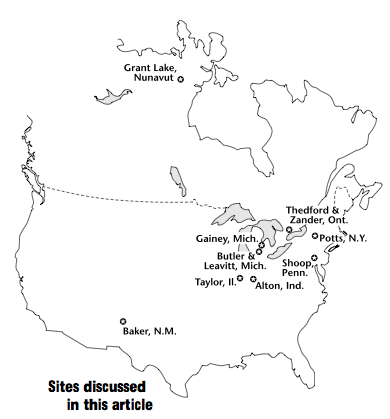
The evidence from particle bombardment
Large quantities of micrometeorite-like particles appear to be concentrated near the boundary between the two layers that have conflicting dates. This suggests that some atmospheric event was responsible for the changes in C-14, and thus the dating errors.
These particles can be separated with a magnet and are identified by the presence of chondrules and by visual evidence of sintering and partial melting. The particles, dissimilar to common magnetites, are found in association with a high frequency of "spherules." Also, total gamma-ray counting of sediment profiles in the various locations invariably showed increased radioactivity at the boundary of these conflicting layers of sedement.
In other words, whatever happened to alter the Carbon-14 was produced in the atmosphere, was extremely hot and radioactive.
The tiny spherical particles were heated at an extremely high temperature during their high-speed entry into the atmosphere. The depth of penetration into the sedement layers implies that these particles entered with substantial energy. Simulations estimate a velocity of about 0.4 kilometers per second.
The evidence of this event is highest at the Michigan, Illinois, and Indiana sites and decreases in all directions from this region, consistent with a widespread catastrophe concentrated over the Great Lakes region. The nearly vertical direction of the tracks left by particle impacts at most sites suggests they came from a distant source (from space) and was not an atmospheric phenomenon near the Earth.""
The evidence from uranium and plutonium
""If a large cosmic-ray bombardment impacted the earth and irradiated the prehistoric landscape with thermal neutrons, the 235 Uranium/238 Uraniam ratio would be changed; 239 Pu would be produced from 238 Uranium capturing an extra neutron, followed by the decay of 239 Uranium. Neutrons colliding with nitrogen (1.83 barns) would create 14 C in exactly the same way 14 C is normally produced in the upper atmosphere, necessarily resetting the radiocarbon dates of any organic materials lying near the surface on the North American prehistoric landscape -- including charcoals at Paleoindian sites -- to younger values.
In other words, intense cosmic radiation from space would produce a bombardment of Carbon-14 atoms on the surface of the Earth. Since C-14 is lost over time, a higher C-14 reading would indicates a younger specimin while a lower C-14 level means an older specimin. This bombardment would cause an artificially higher reading of C-14 atoms when material was being tested and would result in a much younger age estimate.
But scientists also learn about what caused this bombardment by examining the Uranium 235 in the sedement. Compared to U-235 in surrounding area, the ration of U-235 under the region of the bombardment contained about 78 percent as much 235 U as the controls and later-period artifacts, suggesting substantial depletion. The depletion is caused by a bombardment of neutrons; therefore this depletion of 235 U necessarily indicates that thermal neutrons impacted these artifacts and the surrounding prehistoric landscape.""



No comments:
Post a Comment